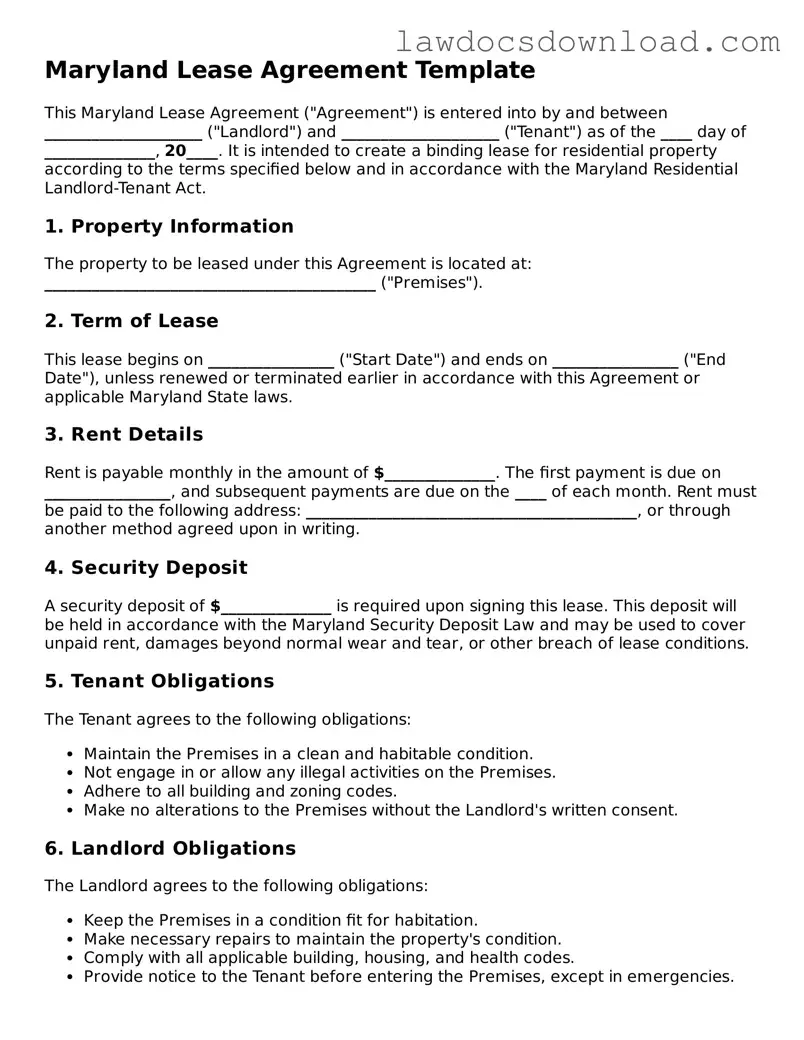Maryland Lease Agreement Template
This Maryland Lease Agreement ("Agreement") is entered into by and between ____________________ ("Landlord") and ____________________ ("Tenant") as of the ____ day of ______________, 20____. It is intended to create a binding lease for residential property according to the terms specified below and in accordance with the Maryland Residential Landlord-Tenant Act.
1. Property Information
The property to be leased under this Agreement is located at: __________________________________________ ("Premises").
2. Term of Lease
This lease begins on ________________ ("Start Date") and ends on ________________ ("End Date"), unless renewed or terminated earlier in accordance with this Agreement or applicable Maryland State laws.
3. Rent Details
Rent is payable monthly in the amount of $______________. The first payment is due on ________________, and subsequent payments are due on the ____ of each month. Rent must be paid to the following address: __________________________________________, or through another method agreed upon in writing.
4. Security Deposit
A security deposit of $______________ is required upon signing this lease. This deposit will be held in accordance with the Maryland Security Deposit Law and may be used to cover unpaid rent, damages beyond normal wear and tear, or other breach of lease conditions.
5. Tenant Obligations
The Tenant agrees to the following obligations:
- Maintain the Premises in a clean and habitable condition.
- Not engage in or allow any illegal activities on the Premises.
- Adhere to all building and zoning codes.
- Make no alterations to the Premises without the Landlord's written consent.
6. Landlord Obligations
The Landlord agrees to the following obligations:
- Keep the Premises in a condition fit for habitation.
- Make necessary repairs to maintain the property's condition.
- Comply with all applicable building, housing, and health codes.
- Provide notice to the Tenant before entering the Premises, except in emergencies.
7. Termination
This lease may be terminated by either party by providing 60 days written notice to the other party, in accordance with Maryland State laws. Specific conditions that would warrant termination include non-payment of rent, violating lease terms, or other breaches as detailed in this Agreement.
8. Governing Law
This Agreement will be governed by and construed in accordance with the laws of the State of Maryland. Any disputes or legal proceedings regarding this Agreement shall be resolved in the jurisdiction where the Premises are located.
9. Signatures
This Agreement is entered into at arm's length, without duress or coercion, and is to be interpreted as an agreement between two willing parties. By signing below, the Landlord and Tenant agree to abide by the terms contained herein.
Landlord Signature: ____________________
Date: ____________________
Tenant Signature: ____________________
Date: ____________________
